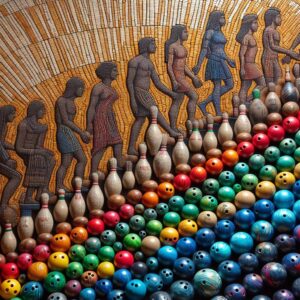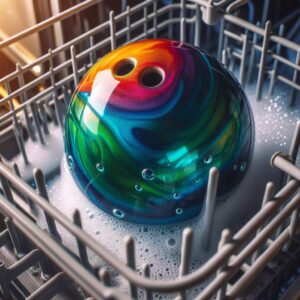If you’re an avid bowler or simply decluttering your garage, you may find yourself wondering what to do with those old, unused bowling balls taking up space.
Unlike regular household waste, bowling balls require proper disposal methods to protect the environment and comply with local regulations.
Don’t worry, we’ve got you covered! In this comprehensive guide, we’ll walk you through the step-by-step process of how to dispose of bowling balls safely and responsibly.
Check Local Regulations
Before you take any action, it’s crucial to understand the laws and regulations surrounding bowling ball disposal in your area. These rules vary from one locality to another, and failing to comply can result in fines or legal consequences.
To find the relevant information, start by visiting your city or county’s website. Look for sections dedicated to solid waste management, recycling, or hazardous waste disposal. Many municipalities provide specific guidance on how to handle large plastic items like bowling balls.
If you can’t find the information online, don’t hesitate to contact your local waste management department or recycling center. They’ll be able to provide you with the most up-to-date regulations and point you in the right direction for proper disposal.
Reasons You May Need to Dispose of a Bowling Ball
There are several reasons why you might need to part ways with your old bowling ball. Perhaps it has developed cracks or damage over time, rendering it unusable for the sport.
Or maybe you’ve invested in a new, high-performance ball and no longer need your old one. Some bowlers may even decide to quit the sport altogether and declutter their equipment.
Regardless of the reason, it’s important to handle the disposal process responsibly. Throwing a bowling ball in the regular trash can have negative environmental consequences and may even be illegal in some areas.
Options for Disposing of an Intact Bowling Ball
If your bowling ball is still in good condition, without any cracks or significant damage, you have a few options to consider:
- Donate to a Youth Club or Organization – Many youth bowling clubs, schools, or community centers may be happy to accept your gently used bowling ball. This not only keeps the ball out of the waste stream but also promotes the sport and provides equipment for those who may not be able to afford a new ball.
- Sell it Online or to a Play-It-Again Sports Store – If your bowling ball is in excellent condition, you may be able to sell it online through platforms like eBay, Facebook Marketplace, or Craigslist. Alternatively, you can take it to a play-it-again sports store, where they buy and resell used sporting goods.
- Recycle it Through a Facility That Accepts Large Plastic Items – Some recycling facilities are equipped to handle large plastic items like bowling balls. Contact your local recycling center or check their website to see if they accept bowling balls for recycling. If they do, they’ll be able to provide specific instructions on how to prepare and drop off the ball.
How to Dispose of a Cracked or Damaged Bowling Ball
If your bowling ball is cracked, damaged, or otherwise unusable, you’ll need to take a different approach to disposal:
a. General Guidelines on Local Landfill/Transfer Station Policies – Many landfills and transfer stations have specific policies regarding the disposal of large plastic items like bowling balls. Some may accept them as part of their regular waste stream, while others may require special handling or fees.
b. Tips for Safely Transporting a Cracked Ball – Transporting a cracked or damaged bowling ball can be risky, as it may shatter unexpectedly. Here are some tips for safe handling:
- Use caution and protective gear like gloves and safety glasses
- Wrap the ball in a thick, sturdy plastic or canvas bag to contain any potential shards
- Secure the wrapped ball in your vehicle to prevent it from rolling around during transport
c. Recycling the Ball’s Core at a Scrapyard – The core of a bowling ball is typically made of dense materials like plastic or resin. If your local recycling facility doesn’t accept whole bowling balls, you may be able to take the ball to a scrapyard that handles mixed materials.
At the scrapyard, they’ll likely have the equipment to safely break down the ball and separate the core from the outer shell. The core can then be recycled, while the shell may need to be disposed of properly.
Proper Handling Precautions
Whether you’re transporting an intact or cracked bowling ball, it’s essential to take proper handling precautions to ensure your safety and the safety of others.
a. Use Caution and Protective Gear When Disposing of Cracked Balls – As mentioned earlier, cracked or damaged bowling balls can be hazardous to handle. Always wear protective gear like gloves, safety glasses, and sturdy shoes when transporting or disposing of a cracked ball.
b. How to Package a Ball for Transportation – If you need to transport a bowling ball, whether intact or cracked, proper packaging is crucial. Here’s how to do it:
- Wrap the ball in a thick, sturdy plastic or canvas bag
- Secure the bag tightly with duct tape or rope
- Place the wrapped ball in a sturdy box or container, surrounded by packing material like bubble wrap or foam peanuts
- Clearly label the package as containing a bowling ball
c. Cleanup Procedures if the Ball Cracks/Shatters – Unexpectedly Despite your best efforts, a bowling ball may crack or shatter unexpectedly during transport or disposal. If this happens, follow these steps for safe cleanup:
- Clear the area of any bystanders or pets
- Wear protective gear like gloves and safety glasses
- Carefully collect all the shards and debris, using a broom and dustpan if needed
- Dispose of the shards and debris according to local regulations for sharp or hazardous waste
Conclusion:
Proper disposal of bowling balls is not only important for the environment but also often required by law. By following the steps outlined in this guide, you can responsibly and safely get rid of your old or damaged bowling balls, whether that means donating, selling, recycling, or properly disposing of them through approved channels.
Remember to always prioritize safety when handling bowling balls, especially if they are cracked or damaged. Use protective gear, follow local regulations, and don’t hesitate to seek guidance from waste management professionals if you’re unsure about any part of the process.
Bowling is a beloved sport, but when it’s time to say goodbye to that old ball, do it right. Share this guide with your fellow bowlers, and together, we can ensure that these large plastic items are handled responsibly, protecting our communities and the environment for years to come.





